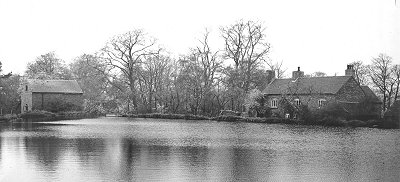THE MILLS OF BUSHBURYThere is evidence and in some cases physical remains of at least eight mills, (two windmills and six watermills), in the parish. Essington windmill, situated a few yards south of the lane from Moseley to Essington to the east of the Cannock road, had a beam dated 1681, but it had probably been renovated more than once in its lifetime. There is a photograph, by W. Bullock, showing this mill, in "Moseley Old Hall", by W. A. Horrox, 1930; and there is an excellent etching in "Remnants of Old Wolverhampton" (1880) by J. Fullwood. Another photograph was reproduced in the "Midland Counties Express" of June 1st 1935 showing the mill about 1915. Coven Heath windmill. The other windmill stood on Coven Heath but was demolished about 1790. No trace remains. Elston Mill stood a few yards west of Elston Hall, and was fed by a stream (now culverted) emerging in Beech Road, via the moat of the Hall. In May 1644 it was assessed to pay thirty shillings per month towards the cost of the Royalist garrison at Dudley Castle. In a terrier of 1753 it was still described as a corn mill, but by 1799 its use was changing. "The mill built with brick and stone and thatched, works one pair of mill stones for grinding (it seems for the tenant's use only) corn, but appears to be chiefly used for turning three or four huge grindstones for the purpose of polishing different kinds of hardware goods." This is presumably the origin of "Whetstone Green."
Moseley Mill. The remains of Moseley Mill can be seen at the northern end of Moseley Pool. On the estate map of Moseley dated 1727 the pool is marked "Mill Pool", so the mill had been built before that date but probably after 1588 when it was not mentioned in the "Beating of the Bounds." At the end of the 19th century the site was used for a water driven electricity generator for Moseley Hall and also for a "ram" to supply water to Moseley Court. Gorsebrook Mill was fed by the Smestow Brook which rises in the Springfields area. It can still be heard rushing through its culvert across the old Gas Works site. St. Peter's Parish Register records the baptism, on 27th August 1613, of Michale, son of Thomas Bennet "of Gosbrook Mill". There is a detailed estimate for the reconstruction of the mill, dated 1739, in the Shaw-Hellier papers, and it apparently continued in use long after Gorsebrook House was built in the eighteenth century. In 1740 the miller was Robert Turner. At the time of the 1841 census its occupier, William Copeland, was using it to grind cement, and in 1861 Michael Mealey is described as a charcoal grinder. One of its wheels was still at Gorsebrook House in the 1930s. Coven Mill, which stood on the western boundary of the parish, is mentioned in the "Beating of the Bounds" in 1588. It ceased working in the nineteenth century, but the remains of its sluice gate, in the stream which fed it, can still be seen a few yards from the west bank of the Staffordshire and Worcestershire canal. (Map Ref.912042). Wobaston Mill. Very little is known about Wobaston Mill, which stood on the south side of Wobaston Lane and was presumably demolished in the nineteenth century when the farmhouse was built, although again, the sluice gates in the stream which fed it were still in place in the 1940s. "There is an ancient deed of Wobaston Mill long before the New Mill or Coven Mill was a Mill." (Bushbury Manor Papers Box S2. Vo1.25. at Hereford Record Office.) There is some evidence of a mill at Showell Manor or Farm - see the map of the Estate of Thos. Shaw-Hellier by R. Timmins: item 20 - Mill Piece & Paddock. (Original map in Staffordshire Archives, R/O/. Copy in the Alex Chatwin Collection, Wolverhampton Archives). |



